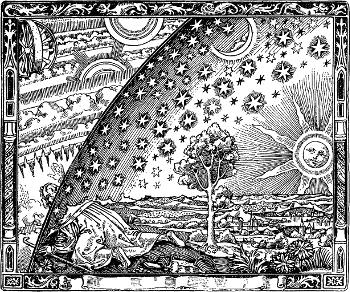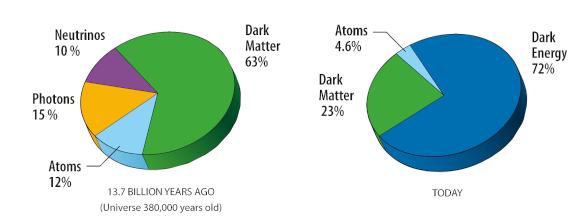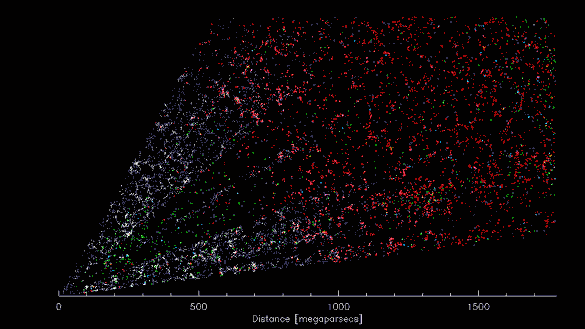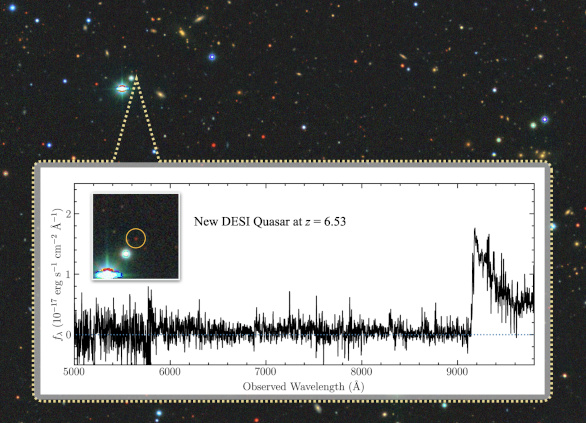Dark Energy
February 28, 2022
One fact about the
universe is that the better we're equipped to
observe it, the larger it gets. We've gone from thinking that our
Earth was surrounded by a collection of close
crystalline spheres to our present
idea that the
diameter of the universe is 93 billion light years based on the concept of
comoving distance. Today, just as in the past, we have always been certain that we finally understood the universe. Based on this
history, should we still insist that our
knowledge is complete?

A wood engraving from page 163 of Camille Flammarion's, L'Atmosphère: Météorologie Populaire (Paris, 1888).
In this image, a pilgrim breaks through a barrier to view the inner workings of the universe that includes a wheel-in-a-wheel mechanism.
Flammarion was an astronomer and a science fiction author who believed that intelligent life existed on Mars. Supporting this assertion was Giovanni Schiaparelli's 1877 discovery of the "Martian canals," which was advanced at that time by American astronomer, Percival Lowell (1855-1916).
(Wikimedia Commons image. Click for larger image.)
This grand
question of what the universe is and our relation to it has led to the development of
cosmologies in all human cultures. Among these, the thread of
cosmological theory in the
Western intellectual tradition is the longest cohesive thread of
scholarship in this area that extends from the
Greek philosophers through more than two
millennia to the
observational astronomy of today. What follows is a list of important highlights from that history. A very good history of cosmology by
James Schombert of the
University of Oregon Department of Physics can be found at ref. 1.[1]
• The Biblical cosmology that predates the Greek philosophers has a flat, circular Earth floating on water and domed by a hemisphere of fixed stars.
• Around the 4th century BC, Aristotle (384 BC-322 BC) proposed a geocentric universe with a finite, but eternal, universe.
• A century later, Aristarchus of Samos (c.310-c.230 BC) proposed a heliocentric universe.
• Around that same time (3rd century BC), Archimedes (c.287 BC-c.212 BC) estimates in The Sand Reckoner that the diameter of the universe is about two light years. I wrote about The Sand Reckoner in an earlier article (The Astronomical Unit, October 3, 2012).
• In a fast forward to the 2nd century, Ptolemy (c.100-c.170) proposed a geocentric universe in which the Sun, Moon, and planets revolve around the Earth.

• Nicolaus Copernicus (1473-1543) publishes De revolutionibus orbium coelestium, which describes his heliocentric universe, in 1543.
(Wikimedia Commons image of Nicolaus Copernicus.)
• In 1610, Johannes Kepler (1571-1630) argues that the dark night sky is evidence for a finite universe. This argument is now known as Olbers' paradox. Edmond Halley (1656-1742), of Halley's comet fame, proposed the same argument in 1720. Heinrich Olbers (1758-1840), for whom Olbers' paradox is named, argued the same in 1826.
• Erasmus Darwin (1731-1802), grandfather of Charles Darwin (1809-1882), proposed a cyclical, expanding and contracting, universe in 1791.
• The great distance to the nearest stars was finally measured in 1837 when Friedrich Bessel (1784-1846), Thomas Henderson(1798-1844) and Otto Struve (1819-1905) measured stellar parallax.
• In 1917, Willem de Sitter (1872-1934) created a relativistic mathematical model for a universe that included a cosmological constant and allowed for expansion.
• On April 26, 1920, at the Smithsonian Museum of Natural History, Director of the Harvard College Observatory, Harlow Shapley (1885-1972), and Heber Curtis (1872-1942), a past president of the Astronomical Society of the Pacific and director of the Allegheny Observatory debated the nature of spiral nebulae. Curtis thought that the spiral nebulae were large and distant independent galaxies, while Shapley argued that the nebulae were just objects at the periphery of the Milky Way. We now know that Curtis was correct.
.jpg)
• Vesto Slipher (1875-1969) discovers galactic redshifts in 1922. A year later, Edwin Hubble (1889-1953) measured the distances to the Andromeda Galaxy (M31), the Triangulum Galaxy (M33), and NGC 6822, showing that these were far outside our Milky Way Galaxy. In 1929, Hubble publishes the linear redshift-distance relation that shows the expansion of the universe.
(Wikimedia Commons image of the Andromeda Galaxy by Dutch astrophotographer, Kees Scherer.)
• In 1933, Fritz Zwicky (1898-1974) found a large quantity of dark matter in the Coma Cluster of galaxies, a discovery that was generally ignored until the 1970s.
• Although Hermann Bondi (1919-2005), Thomas Gold (1920-2004), and Fred Hoyle (1915-2001) were still arguing for a steady state universe in 1948, that same year, George Gamow (1904-1968) predicted the cosmic microwave background radiation, a consequence of the creation of the universe that's now called the Big Bang. This radiation was accidentally discovered by Bell Labs physicists, Arno Penzias (b. 1933) and Robert Wilson (b. 1936), in 1965.
• By the 1980s, the idea that the universe was mostly cold dark matter had become respectable.
• By 1992, the blackbody spectrum of the cosmic microwave background radiation and its very small anisotropy were measured to extreme precision. In 2003, NASA's Wilkinson Microwave Anisotropy Probe continued measurements of the cosmic microwave background radiation to give us its age of 13.7 billion years and other useful data (see figure). The age of the universe from other observations was previously thought to be 18-20 billion years. Whether 13.7 or 20 billion years, these are quite different from Aristotle's eternal universe.

Composition of the universe, at an early epoch, and today. These data are from the Wilkinson Microwave Anisotropy Probe.[2] As a consequence of the limited accuracy for dark matter and dark energy detection, the percentages don't add to 100% (Reformatted NASA image by the WMAP Science Team. Click for larger image.)
One recent newcomer to our understanding of the universe is the existence of
dark energy. While dark matter has the affect of pulling the universe together, via
gravitation, dark energy is what's responsible for the
accelerated expansion of the universe. While dark matter was new to us in the 1930s, it wasn't until a few decades ago that there was general agreement that dark energy exists. This is just more evidence of how elusive our universe has been, and the idea that as we look harder we'll continue to discover more
surprises.
The
Dark Energy Survey (DES) Collaboration, whose members from 78
research institutions are too numerous to name, have just
published their
analysis of the large-scale
structure of the universe in a
field of 5000 deg
2, which is about one eighth of the entire sky.[3-5] This derives from three years of observations by the
Dark Energy Spectroscopic Instrument (DESI) at
Kitt Peak, and it creates the largest and most detailed three-dimensional galaxy survey map ever made. This follows a 2018 publication of data from the first year of observations that covered 1514
deg2.[5] The new influx of data allows for a two-fold increase in
statistical signal-to-noise ratio.
The DES Collaboration used three statistical measurements of galaxies to determine some important cosmological parameters that included the dark matter
density and the cosmic expansion rate.[5] Their analysis supports the standard cosmological model known as
Lambda-CDM (ΛCDM) to the exclusion of most others, and this allowed calculation of the
amplitude of
matter clustering and the dark energy
equation of state.[5]

A two-dimensional representation of a three-dimensional DESI scan of a portion of the universe. Earth is at the apex, and the scan extends 5 billion light years and sweeps from the constellation Virgo to Boötes and Corona Borealis. Each colored point represents a galaxy.
(Lawrence Berkeley National Laboratory image by D. Schlegel/Berkeley Lab using data from DESI.)
DESI operates by
robotic positioning of 5000
optical fibers to 10
micrometer accuracy with each fiber collecting a detailed
optical spectrum.[4] The survey has now cataloged more than 7.5 million galaxies, and it's adding a million more each month. In November 2021 alone, DESI cataloged redshifts from 2.5 million galaxies. By the end of its run in 2026, DESI is expected to have over 35 million galaxies in its catalog.[4] As an additional benefit, DESI has discovered a
quasar with a
redshift z = 6.53 that existed less than a billion years after the Big Bang (see figure).

A quasar with a redshift z = 6.53 discovered by DESI. This quasar existed less than a billion years after the Big Bang. For scientists more familiar with nanometers than angstroms, 9000 Å = 900 nm, which places the peak in the near infrared.
(Lawrence Berkeley National Laboratory image by Jinyi Yang, Steward Observatory/University of Arizona. Click for larger image.)
References:
- James Schombert, "Astronomy 123: Galaxies and the Expanding Universe: Cosmology," University of Oregon Department of Physics.
- WMAP- Content of the Universe, NASA Web Site.
- T. M. C. Abbott, et al. (DES Collaboration), "Dark Energy Survey Year 3 results: Cosmological constraints from galaxy clustering and weak lensing," Phys. Rev. D, vol. 105, no. 2 (January 15, 2022), Article no. 023520, DOI:https://doi.org/10.1103/PhysRevD.105.023520.
- Adam Becker, "Dark Energy Spectroscopic Instrument (DESI) Creates Largest 3D Map of the Cosmos," Lawrence Berkeley National Laboratory Press Release, January 13, 2022.
- Michael Schirber, "Dark Energy Survey Hits a Triple," Physics, vol. 15, January 13, 2022.
Linked Keywords: Universe; observational astronomy; Earth; celestial spheres; crystalline spheres; idea; observable universe; diameter of the universe is 93 billion light years; comoving distance; history; knowledge; Camille Flammarion woodcut; L'Atmosphère: Météorologie Populaire (Paris, 1888), pp. 163; wood engraving; pilgrim; barricade; barrier; Ophanim; wheel-in-a-wheel; astronomer; science fiction; author; intelligent; extraterrestrial life; Mars; Giovanni Schiaparelli; Martian canals; United States; American; Percival Lowell (1855-1916); Wikimedia Commons; question; timeline of cosmological theories; cosmologies in all human cultures; cosmology; cosmological theory; Western canon; Western intellectual tradition; scholarly method; scholarship; Ancient Greek philosophy; Greek philosophers; millennia; James Schombert; University of Oregon Department of Physics; Bible; Biblical; plane (geometry); flat; circle; circular; buoyancy; floating; water; dome; domed; sphere; hemisphere; fixed stars; 4th century BC; Aristotle (384 BC-322 BC); conjectured; proposed; geocentric model; infinity; finite; eternity; eternal; century; Aristarchus of Samos (c.310-c.230 BC); heliocentrism; heliocentric; 3rd century BC; Archimedes (c.287 BC-c.212 BC); approximation; estimate; The Sand Reckoner; diameter; light years; 2nd century; Ptolemy (c.100-c.170); Sun; Moon; planet; rotation; revolve; Nicolaus Copernicus (1473-1543); De revolutionibus orbium coelestium; Johannes Kepler (1571-1630); night sky; evidence; Olbers' paradox; Edmond Halley (1656-1742); Halley's comet; Heinrich Olbers (1758-1840); Erasmus Darwin (1731-1802); grandfather; Charles Darwin (1809-1882); circle; cyclical; expansion (geometry); expanding and contracting; star; measurement; measure; Friedrich Bessel (1784-1846); Thomas Henderson(1798-1844); Otto Struve (1819-1905); stellar parallax; Willem de Sitter (1872-1934); theory of relativity; relativistic; mathematical model; cosmological constant; Smithsonian Museum of Natural History; director; Harvard College Observatory; Harlow Shapley (1885-1972); Heber Curtis (1872-1942); president; Astronomical Society of the Pacific; Allegheny Observatory; debate; debated; spiral nebulae; galaxy; galaxies; periphery; Milky Way; Vesto Slipher (1875-1969); galactic; redshift; Edwin Hubble (1889-1953); Andromeda Galaxy (M31); Triangulum Galaxy (M33); NGC 6822; Hubble's law; linear redshift-distance relation; Netherlands; Dutch; astrophotographer; Kees Scherer; Fritz Zwicky (1898-1974); dark matter; Coma Cluster; Hermann Bondi (1919-2005); Thomas Gold (1920-2004); Fred Hoyle (1915-2001); steady-state model; steady state universe; George Gamow (1904-1968); cosmic microwave background radiation; Big Bang; electromagnetic radiation; serendipity; accidentally; Bell Labs; physicist; Arno Penzias (b. 1933); Robert Wilson (b. 1936); 1980s; blackbody; emission spectrum; anisotropy; accuracy and precision; NASA; Wilkinson Microwave Anisotropy Probe; Age of the universe; data; composition of the Universe, at an early epoch, and today; epoch (astronomy); dark energy; percentage; gravitation; accelerated expansion of the universe; surprise (emotion); Dark Energy Survey (DES) Collaboration; research institution; scientific literature; publish; data analysis; structure; field of view; Dark Energy Spectroscopic Instrument (DESI); Kitt Peak; square degree">deg2; statistics; statistical; signal-to-noise ratio; density; Lambda-CDM model; ΛCDM; amplitude; matter; equation of state; two-dimensional space; three-dimensional space; apex (geometry); constellation; Virgo (constellation); Boötes; Corona Borealis; point (geometry); Lawrence Berkeley National Laboratory; robot; robotic; optical fiber; micrometer; optics; optical; quasar; edshift; scientist; nanometer; angstrom; near infrared.